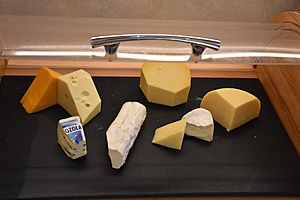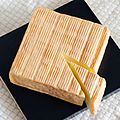Cheese facts for kids
Cheese is a yummy dairy food made from milk. There are so many kinds of cheese! Think of cheddar, Swiss, and provolone.
Many things change how a cheese looks, feels, tastes, and its color. These include the type of milk used (like cow or goat milk). It also matters if the milk was pasteurized (heated to kill germs). The amount of butterfat, tiny bacteria, and even mold can change it. How the cheese is made, how much fat it has, and how old it is also play a big part. For example, some cheeses are soft and fresh, while others are hard and aged for years!
Contents
The Story of Cheese
Cheese is a very old food. People were making it even before history was written down! We don't know exactly where cheesemaking started. It could have been in Europe, Central Asia, or the Middle East. Some think it began around 8000 BCE, when sheep were first tamed.
The oldest proof of cheesemaking is from about 5500 BCE in what is now Kuyavia, Poland. Scientists found old strainers with milk fat on them. This shows people were making cheese a long, long time ago!
Cheesemaking might have started as a way to keep milk from spoiling. People would press and salt milk that had gone lumpy. Early pictures of Egyptian cheese were found in old Egyptian tombs from around 2000 BCE. In 2018, scientists found what they think is the world's oldest cheese in an ancient Egyptian tomb. It was about 3200 years old!
The first cheeses were probably quite sour and salty. They might have been like cottage cheese or feta, which is a crumbly Greek cheese. In Europe, where it's cooler, cheese needed less salt to stay good. With less salt, good microbes and molds could grow. These tiny helpers give aged cheeses their special flavors. The oldest preserved cheese ever found was in China. It was about 3600 years old!
How Cheese is Made
Cheese starts with milk. The most common milk comes from cows, goats, and sheep. But you can also use milk from buffalo, camels, or even donkeys! Cheesemakers usually cook the milk in big pots.
Most cheeses are made a bit sour by special bacteria. These bacteria turn the milk's sugar into lactic acid. This makes the milk start to thicken.
Next, Salt is added. Then, a special ingredient called rennet is often used. Rennet helps the milk curdle and become solid. Some cheesemakers use other ways to curdle the milk instead of rennet. For example, vegetarian rennet can be made from a fungus or from plants like the Cynara thistle.
Other ingredients might be added too. After that, the cheese is usually left to get older, or "aged," for different amounts of time. This aging process gives cheese its unique taste and texture.
Types of Cheese
There are many ways to sort and describe cheeses. Here are some common ways:
- How long the cheese was aged (some are fresh, some are aged for years!)
- The texture of the cheese (is it hard, soft, or somewhere in between?)
- How the cheese was made (different steps create different cheeses)
- What kind of milk was used (cow, goat, or sheep milk makes a big difference). Even what the animal ate can change the cheese!
- How much fat is in the cheese (some are low-fat, some are rich)
- What color the cheese is (most are yellow or white)
There are also foods that look and taste like cheese but are not made from milk. These are called Cheese analogues.
Here are some different types of cheese you might know:
Cheese and Your Health
Cheese has different amounts of nutrients depending on the type. For example, cottage cheese has less fat than a creamy triple-crème cheese. Generally, cheese is a good source of calcium (which helps build strong bones), protein (for muscles), and phosphorus. It also has sodium and saturated fat. A small piece of cheddar cheese (about one ounce) has around 7 grams of protein and 202 milligrams of calcium. Think of cheese as milk that has been made more concentrated through the cheesemaking process.
Food Safety
Some health groups suggest being careful with cheeses made from raw (unheated) milk. This is because raw milk can sometimes have germs that might make you sick. In some places, like the U.S., raw-milk cheeses must be aged for at least 60 days to make them safer. Many cheeses today are made with pasteurized milk, which means the milk was heated to kill any harmful germs. This makes the cheese safer to eat.
Pregnant women are often advised to avoid soft, mold-ripened cheeses (like Brie or blue cheese) because of a small risk of a germ called listeria, which can be harmful.
Images for kids
-
A piece of soft curd cheese, oven-baked to increase shelf life
-
Cheeses in art: Still Life with Cheeses, Almonds and Pretzels, Clara Peeters, c. 1615
-
Cheese in a market in Italy
-
Cheese, Tacuinum sanitatis Casanatensis (14th century)
-
Cheese display in grocery store, Cambridge, Massachusetts, United States.
-
During industrial production of Emmental cheese, the as-yet-undrained curd is broken by rotating mixers.
-
Cheese factory in the Netherlands
-
Parmigiano-Reggiano in a modern factory
-
A traditional Polish sheep's cheese market in Zakopane, Poland
-
Brie cheese
-
Devil's Gulch cheese
-
Isle of Mull Cheese
-
Diverse Sauermilchkäse sour cheese
See also
 In Spanish: Queso para niños
In Spanish: Queso para niños

























































